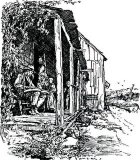The parting hand is an old, old practice in Southern singings, as singers go around the room shaking hands during the last song or "closer." But it sort of fell by the wayside in Midwestern singings, at least the ones I've been to in downstate Illinois, when we stopped using the old William Walker song The Parting Hand (No. 62) as a closer. But as we sang Christian's Farewell, a couple of people started shaking hands around the hollow square. A few more of us joined in, and then more ... and the scene in Millikin's ultra-modern Pilling Chapel carried me back to singings in pine-plank country churches down home in Tennessee. It felt good to be doing it again, and in an adapted form that celebrates both the people I first learned the music from and the people I sing with now. And of course, that's how traditions survive. They adapt.
Sunday's singing (Feb. 26) at Millikin was about handing down traditions. Several members of the university's choir were on hand, and student organizer Ryan Henry said there's quite a bit of enthusiasm for the Sacred Harp tradition among music students on campus. "They've been hearing me talk about it since my first convention in '04," he said. Also instrumental in exposing students to the tradition has been choir director Bradley Holmes, who includes shape-note hymns in the choir's repertoire.
So the singing at Millikin took on some of the atmosphere of a singing school, as Terry Hogg of Decatur, Janet Fraembs and Peggy Brayfield of Charleston, and Berkley Moore of Springfield explained how to sing the shapes, how to lead a song and how to find the intervals in major and minor modes without a key signature.
"We sing in keys of convenience," said Peggy, to appreciative laughter from the music students. "If you have perfect pitch, this may drive you crazy. But don't think we're doing it wrong. We're doing it right [according to the tradition]."
A few minutes later, university choir member Dan Simpson said as far as he's concerned, the tradition does it right. Taking us through a choral arrangement of Windham by 18th-century tunesmith Daniel Read, he said, "This music has a sound that's unrivaled anywhere."
We didn't keep formal minutes, but I jotted down leaders (except a time or two when I got caught up in the music and forgot to take notes). The lesson included:
Terry Hogg 49t, Pete Ellertsen 49b, Janet Fraembs 155, Peggy Brayfield 128, Lori Graber 148, Conrad Wetzel 84, Terry Hogg 29, Terry Hogg joined by Dan Simpson 32t, Dan Simpson 38, Lori Graber 163b, Pete Ellertsen 312b, Peggy Brayfield joined by Megan Murray 284, Ryan Henry 282, Peggy Brayfield 335, Terry Hogg 299, Pete Ellertsen 510, Berkley Moore 99, Lamar Schlabach 48t, Peggy Brayfield 268, Janet Fraembs 385. The class was dismissed with prayer by Berkley Moore, and the closing song was 347.In addition to the students from Millikin, 25 to 30 singers from the Charleston-Mattoon area, Champaign and Urbana, Delavan, Ashland, St. Louis, Jacksonville and Springfield were on hand. Decatur is a good central location, and it was wonderful to see so many college students taking an interest in our way of singing.
A footnote. While I remember closing with Walker's Parting Hand at singings in East Tennessee, considerable variation is customary within the various shape-note traditions. Here's a brief explanation from the notes to Jim Carnes' documentary Sweet is the Day about an important traditional singing family in North Alabama:
As is the custom at many Sacred Harp singings, they close with the song "Parting Hand," in this case following immediately with a verse from "Hallelujah" [another song, No. 146]. This parting ritual marks the dispersal of the singing family. It follows the closing prayer, a prayer which implores that singers arrive safely at their various residences. The end of a singing is a time of impending absence — from one's fellow singers and from the vivid spiritual presence that is Sacred Harp.Sweet is the Day is available in VHS and DVD format from the Alabama Folklife Association in Montgomery.

